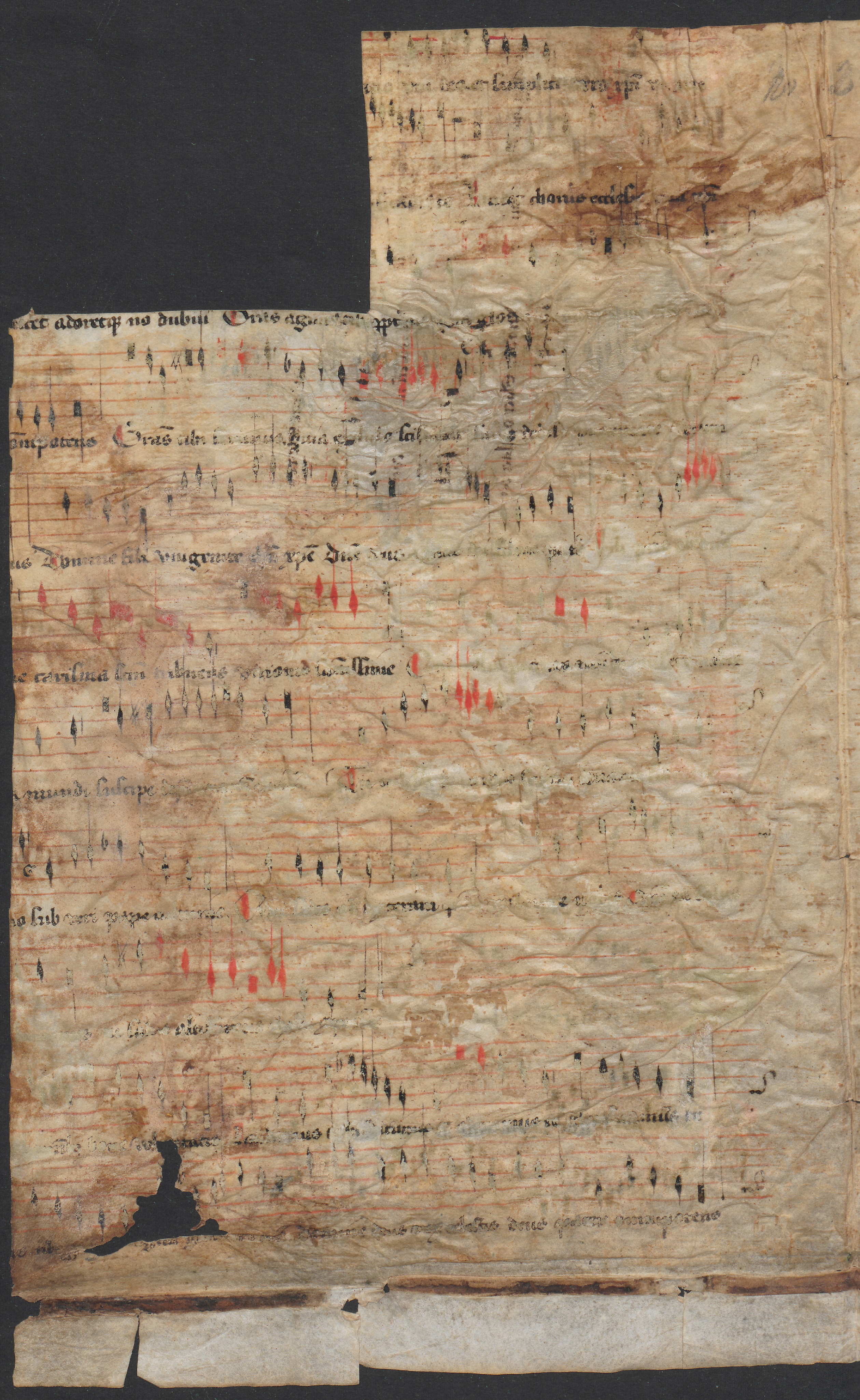Digital Musicology #1: Medieval sources brought back to life
Guest Blog Post by Eliane Fankhauser, Utrecht University, E.A.Fankhauser@uu.nl
From the very beginning of my research project about polyphonic music in the northern Low Countries in the late Middle Ages, it has been clear that my main objects of research would consist of a few loose parchment leaves some of which were in a very bad state. As these parchment leaves are the only witnesses of polyphonic music in the northern Low Countries around 1400, I considered the improvement of their legibility crucial for the progress of my research project.
Doubtlessly, I was not the only one who attributed particular importance to enhancing the legibility of the said fragments. Traces of restoration from the beginning of the 20th century can be found on some of the fragment leaves. Restorers at the time aimed to bring to the fore vanished script by applying a chemical solution to the relevant passages. As a result, dark brown stripes appear on the fragments today, the script underneath having vanished nevertheless. From today’s perspective, the physical restoration of the fragments was not an option.
At the start of my project in the autumn of 2013 I had already heard about digital methods to restore images of fragments or manuscript pages. Because these methods are digital no damage can be done to the sources whilst the possibilities to enhance legibility are almost unlimited. Thanks to Julia Craig-McFeely and Alan Lock, who published a comprehensive workbook on digital restoration in 2006, I was in the lucky position to have at hand a manual with the help of which I carried out my first digital restorations on ‘my’ fragments.
In this blog, I would like to highlight one particular technique I applied in the course of the restoration of some of the fragment images: to re-combine two complementary images of one and the same fragment. The fragments were used as binding material in printed books from the early sixteenth century and were glued to the front and the back of book covers. Upon their removal some of the ink remained on the wooden book covers. Today, the content is thus divided between the fragments themselves and the wooden book cover. Luckily, the imprints on the book covers are in an exceptionally good state but obviously they cause major gaps on the original fragment leaves. It thus goes without saying that bringing together the original content and its imprint yield a more complete content. On top of that, digital restoration techniques are most suitable for doing exactly this. No sooner said than done!
High-resolution images of both the fragment leaf (‘image 1’ hereafter) and its imprint (‘image 2’ hereafter) on the book cover formed the basis of this kind of restoration. In a first step both images were restored. That is, the script and music notation on both images were selected and their colors intensified. The background was made paler in order to increase contrast. Image 2, moreover, needed to be flipped horizontally because the imprint of the script appeared mirrored. Then, I superimposed image 2 on image 1.


Left: Original fragment page (image 1) Utrecht, Universiteitsbibliotheek, NL-Uu 37.I, fol. IIIAv; Right: imprint (flipped) on the wooden cover of the host book (image 2) Utrecht, Universiteitsbibliotheek, NL-Uu 37.I-folio_IIIAv
The first result was disappointing: it appeared that the fragment itself had shrunk over time whereas the imprint did not. This made impossible the precise alignment of the two images, which is essential in fitting the content. After some unsuccessful trials changing the angle of image 2, it was clear that cutting image 2 in small bits and aligning them one after the other was the only possibility to make both images match. Indeed, even though this technique was very time consuming, it yielded a satisfying result: For the first time hitherto illegible script and music were made visible again.

An image of the combination of both (thus the final result of the restoration), Utrecht, Universiteitsbibliotheek, NL-Uu 37.I, fol. IIIAv
Two components were of great importance for the success of this particularly challenging kind of digital restoration. On the one hand, there is the availability of high-resolution images. The higher the quality of the image, the more precise and accurate the restoration will be, as many of the tools used are based on color selection. The color, in turn, can be detected most efficiently by zooming in and selecting pixels of distinct colors. On the other hand, the communication with the institution housing the sources and its willingness to cooperate is central, especially in more complicated cases such as the one introduced here. Without the cooperation of the Special Collections of the Utrecht university library, which made available several more images of the imprints, the overall result of the restoration, doubtlessly, would have been of lower quality.
This brings me to an aspect of digital restoration, which I would like to mention as a final point here. Restoration as used in research on early music primarily serves the purpose to make legible content invisible to the naked eye. Digital restoration can be used as an instrument for the embellishing of the overall impression of a source (the discussion of ethically correct digital restoration I deliberately do not address here). It is, however, more often used purely to make visible content in the case of which the restored image is not meant to be presented to a broader audience.
Digital restoration is of great help for research on early music, as it makes possible the re-discovery of music and text. The Middle Ages got their epithet as “the dark ages” primarily because so little documentation is available today. If we are able to get out more of the sparse sources we happen to have, it can only be in favor of this distant and yet so fascinating period of time.
